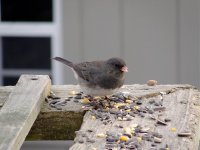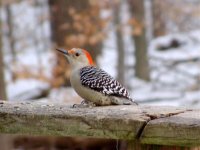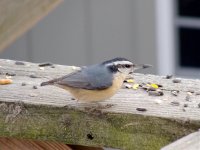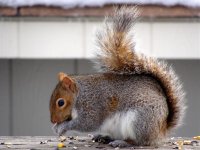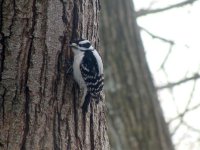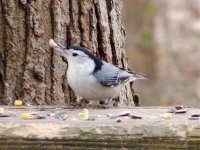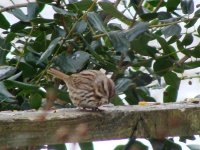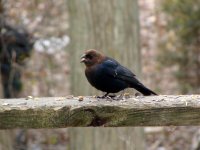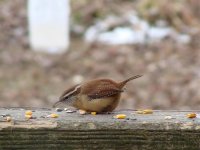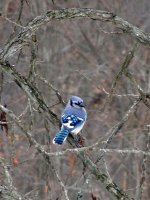Elk River Rancher
Casual Birder
I've noticed a distinct difference in the population, at the deck, yesterday morning; and today, too ... the delightful flock of dark eyed juncos seems significantly reduced, in numbers. They, along with the white throat sparrows and the cardinals, are usually here at the deck very early - and generally 'root around' the leaf debris under the holly and between the house and the garage. Their soft vocalisations are missed - and I wonder how soon they'll depart for points northward (they are not year 'round residents, in my woodlands here on the Elk River, in Maryland, USA.).
As the morning progresses, the blue jays, red-bellied and downy woodpeckers, the white and the rosy breasted nuthatches, the chickadees and titmice, and the occasional 'vagrant' (a mourning dove or two, sometimes a song sparrow) visit the deck railing, finding places between the grey squirrels to land and get a seed or two.
The ubiquitous flocks of grackles, red wing, and brown-headed cowbirds will then sound their clarion call, and swoop in for the attack on the buffet, clearing it completely within two or three minutes. I've tried to manage these hungry hoards by putting cracked and whole corn off to the side of the drive - and it does help, somewhat, to divert the black river of ravenous birds from the 'pricier' seeds and peanuts - but not for long. I usually have to take my morning coffee at the dining room table, and act as the 'scarecrow', jumping up from my seat when the black birds begin to lite upon the railing. They are strong in number, but faint of heart, and take wing the moment my chair legs scrape the floor, as I push away from the table.
This has not been quite as harsh a winter, in 'snow cover' - but it's been very cold. But, for the first time in months, the temperatures reached into the mid 50's (F, of course ...), yesterday - and I spotted a robin in the holly bush. It's not likely a 'returnee' - more likely a member of its species that decided to winter here. Although today is back down to freezing and just above, the weatherman promises temp will be back to the upper 50's by week's end. February is the cruelest month ... no matter what Eliot wrote.
Who has their bags packed, in your neck of the woods?
As the morning progresses, the blue jays, red-bellied and downy woodpeckers, the white and the rosy breasted nuthatches, the chickadees and titmice, and the occasional 'vagrant' (a mourning dove or two, sometimes a song sparrow) visit the deck railing, finding places between the grey squirrels to land and get a seed or two.
The ubiquitous flocks of grackles, red wing, and brown-headed cowbirds will then sound their clarion call, and swoop in for the attack on the buffet, clearing it completely within two or three minutes. I've tried to manage these hungry hoards by putting cracked and whole corn off to the side of the drive - and it does help, somewhat, to divert the black river of ravenous birds from the 'pricier' seeds and peanuts - but not for long. I usually have to take my morning coffee at the dining room table, and act as the 'scarecrow', jumping up from my seat when the black birds begin to lite upon the railing. They are strong in number, but faint of heart, and take wing the moment my chair legs scrape the floor, as I push away from the table.
This has not been quite as harsh a winter, in 'snow cover' - but it's been very cold. But, for the first time in months, the temperatures reached into the mid 50's (F, of course ...), yesterday - and I spotted a robin in the holly bush. It's not likely a 'returnee' - more likely a member of its species that decided to winter here. Although today is back down to freezing and just above, the weatherman promises temp will be back to the upper 50's by week's end. February is the cruelest month ... no matter what Eliot wrote.
Who has their bags packed, in your neck of the woods?




